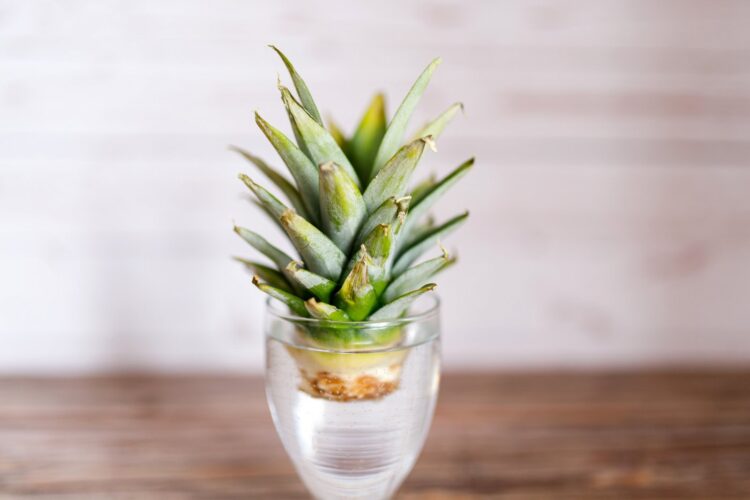How can you grow your own pineapple?
You don’t have to visit Hawaii to get high-quality pineapples harvested at the peak of ripeness.
In fact, it is entirely possible to raise your own sweet, juicy, plant-ripened pineapples without a trip to the islands.
By Louisiana State University Agricultural Center Horticulturists Dan Gill and Allen Owings
Patience for pineapples?
Pineapples aren’t hard to grow, other than providing protection during the winter. The plants are tough and aren’t prone to insect or disease problems.
Producing a pineapple does require some patience, however. It usually takes about two years or more from planting to produce a ripe fruit.
During that time, though, the pineapple plant makes a very attractive foliage plant. Spring or early summer is an ideal time to get started.
MORE: How do you choose a ripe pineapple?
How to begin growing your own pineapple
To grow you own pineapple, start with a fruit purchased at the supermarket. Choose one that has a healthy, green, leafy top (or crown) and that’s wasn’t too badly battered during processing and shipping.
To root the top, you will need a gallon-size container, enough potting soil to fill it, slow-release fertilizer, a sharp knife and pruning shears.
First, use a sharp knife to cut the crown from the fruit. Make the cut cleanly and as close to the fruit as you can.
Next, remove enough of the lower leaves from the cut crown to expose about one-half to three-quarters of an inch of stem. Lay the crown aside for three days to allow the cut to callus over.
Fill the gallon container almost full of the potting soil and add the slow-release fertilizer according to label directions.
Plant the pineapple top just deep enough to cover the exposed stem, firming the soil around it to make it stable. (If necessary, you can insert two or three pencils in the soil to hold the top in place.)
Water the plant thoroughly and place it in a shady area outside to root. The crown should root in a couple of weeks.

Your pineapple after a couple of weeks
After the crown is rooted, move the plant into part sun for a week, and then move it into full sun. Grow your pineapple in full sun outside throughout the summer, keeping it well watered.
In three to four months, the plant will have outgrown the gallon pot. At this time, shift it to a three-gallon-sized container using the same well-drained potting soil and some more slow-release fertilizer.
The plant will produce its fruit in this pot. The larger pot is important. If kept in a small pot, the plant will produce a smaller, poorer-quality fruit.
Going into the winter, it is important to remember that the pineapple continues to need full sun, but it is not able to tolerate freezing temperatures.
>> Vintage pineapple recipes from 1961: Pineapple sun fest recipe ideas
You have two options: One — leave your plant outside in full sun through the winter, but bring it into a protected location on those nights when temperatures are expected to dip below the upper 30s. Return the plant to full sun as soon as possible. Two — overwinter the plant in a greenhouse or on a sunny window.
As your pineapple grows
By the second summer, the original small crown should have grown into a large, handsome plant about 2 feet across. At this stage, your plant should flower. The first sign of flowering is a bright red color in the center of the plant.
Soon, a stalk will appear with lavender flowers peeking out from a structure at the top shaped like a small pineapple. This structure will develop into the fruit.
>> Recipe for pineapple-marinated grilled chicken sliders
From flowering to ripe fruit takes about five months. You can generally harvest a ripe pineapple in the fall of the second year from a spring- or early-summer-rooted crown. The fruit you get should be about the same size or a little smaller than those at the supermarket. Or if you did a great job, maybe even a little larger.
Deciding when to harvest the pineapple is especially important. The idea is to allow it to fully ripen on the plant. If you harvest too soon, it won’t be as sweet. If you aren’t sure, it’s better to leave the pineapple on the plant too long than to harvest it too soon. When ripe, pineapple fruit stores fairly well on the plant, so you don’t need to be as worried about leaving it on too long as much as harvesting too early.
A pineapple fruit is ready to harvest when the background color changes from green to gold. The feel of the fruit will go from rock hard to slightly soft – giving a little to firm pressure with your thumb. Also, the fruit will develop a rich, pineapple smell. Use all of these signs when deciding when to harvest the fruit.
Each plant will produce a single fruit and then die. You can, however, start new plants from the crown of the fruit you harvest, from slips that form on the flower stem, or from suckers that appear at the base of the original plant. And after growing them once, you are sure to want to grow pineapples again.
The pineapple belongs to the bromeliad family, and originated in tropical South America. Its Latin name is Ananas comosus, and it’s related to the bromeliads grown as ornamentals, and also to the Spanish moss commonly seen hanging from trees in the South.
The flavor of a plant-ripened pineapple has to be experienced to be believed. You are in for an exceptional treat.







